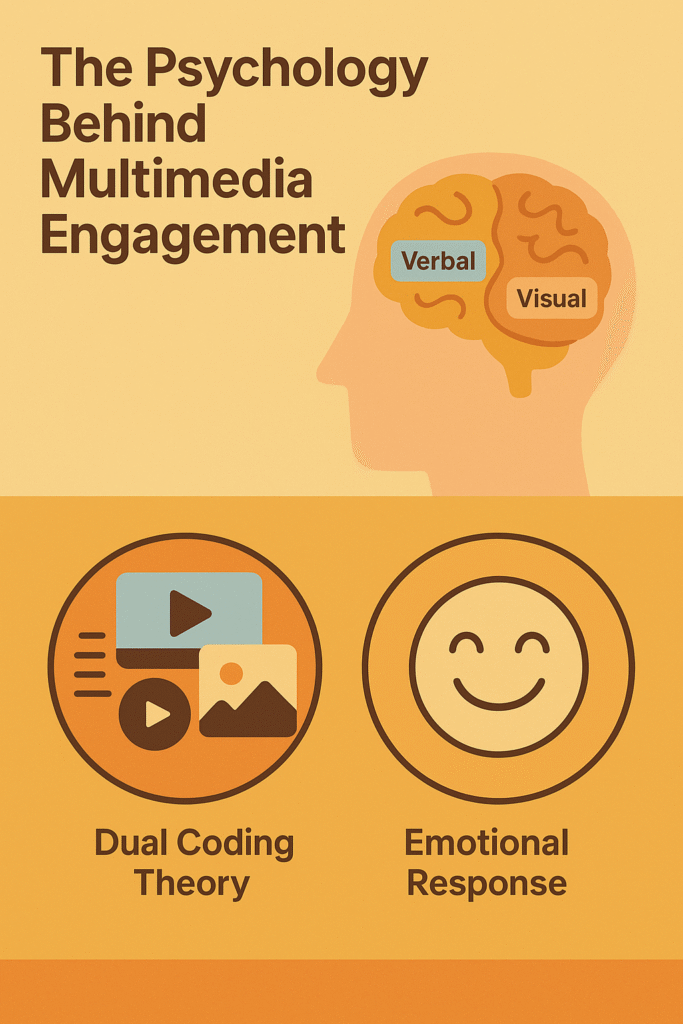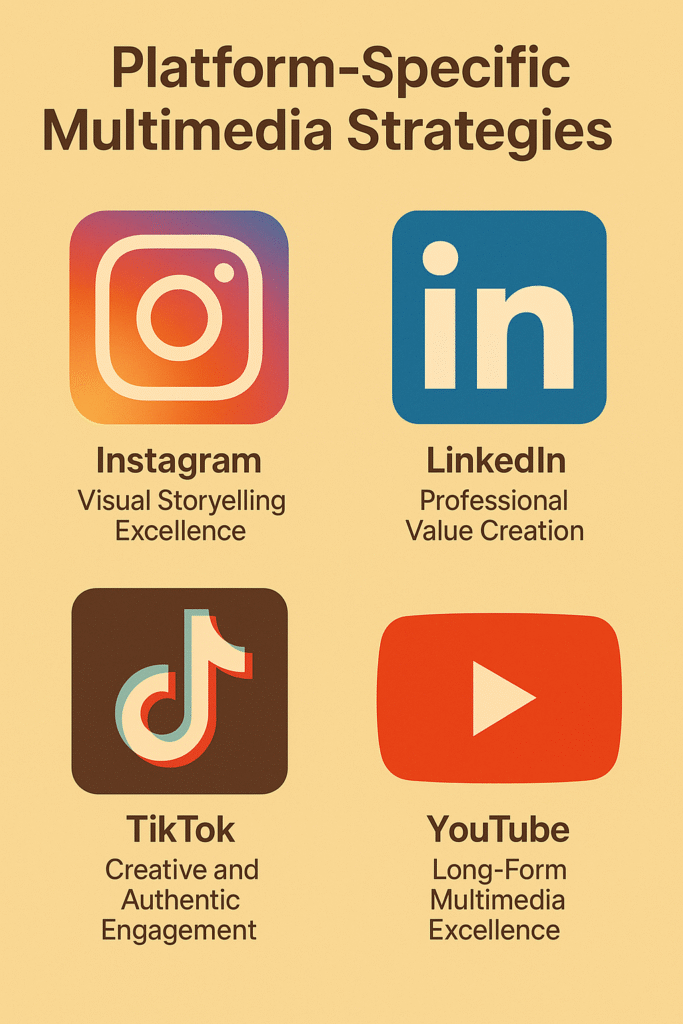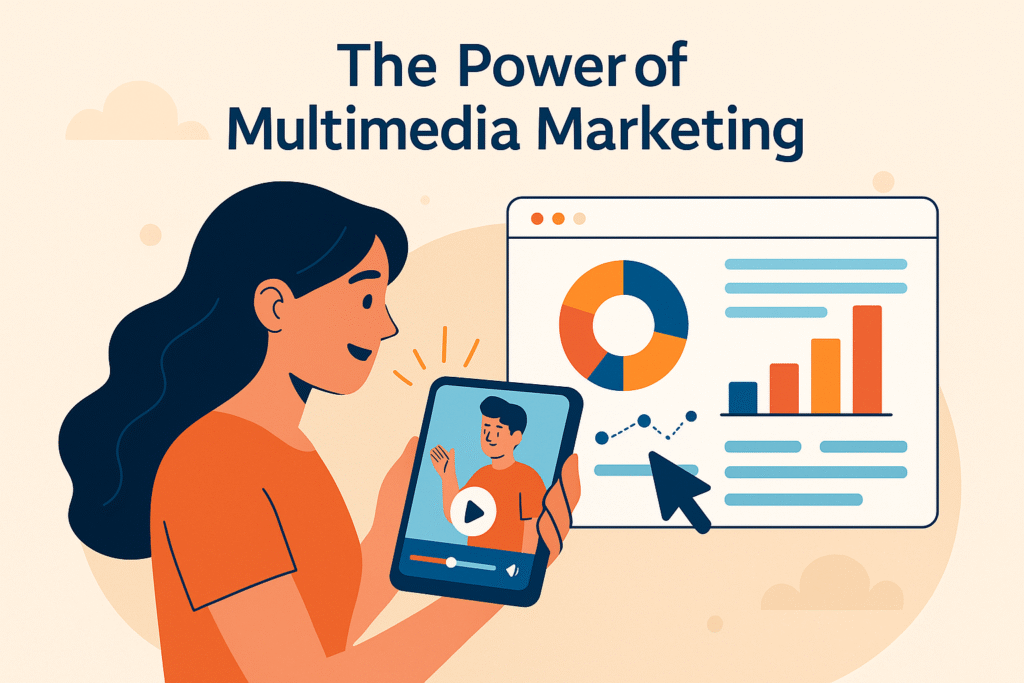Picture this: You’re scrolling through your social media feed, and suddenly you stop. A vibrant video catches your eye, followed by an interactive infographic that makes you want to click and explore. Within seconds, you’re hooked. This is the power of multimedia marketing – and it’s revolutionizing how brands connect with their audiences.
In today’s digital landscape, where attention spans are shorter than ever, multimedia marketing has become the secret weapon for enhancing audience engagement. Gone are the days when simple text posts could capture and hold your audience’s attention. Modern consumers crave rich, interactive experiences that speak to their senses and emotions.
Table of Contents
Multimedia Marketing in the Modern Era
Multimedia marketing combines various content formats – videos, images, audio, interactive elements, and text – to create compelling brand experiences. This approach recognizes that different people absorb information in different ways. While some prefer visual content, others respond better to audio or interactive elements.
The beauty of multimedia marketing lies in its versatility. It allows brands to tell their stories through multiple channels simultaneously, creating a cohesive narrative that resonates with diverse audience segments. When done correctly, it doesn’t just inform – it captivates, educates, and inspires action.
Research shows that visual content is processed 60,000 times faster than text by the human brain. This statistic alone highlights why multimedia approaches are essential for increasing audience engagement in our fast-paced digital world.
The Psychology Behind Multimedia Engagement

Understanding why multimedia works requires diving into human psychology. Our brains are wired to process multiple types of information simultaneously. When we encounter multimedia content, different areas of our brain activate, creating a more immersive and memorable experience.
The concept of dual coding theory explains this phenomenon. Developed by Allan Paivio, this theory suggests that information is better retained when it’s processed through both verbal and visual channels. Multimedia marketing leverages this psychological principle by presenting information in various formats, making it more likely to stick in your audience’s memory.
Furthermore, multimedia content triggers emotional responses more effectively than single-format content. When someone watches a video with compelling visuals and audio, they experience a stronger emotional connection to the brand. This emotional engagement is crucial for building long-term customer relationships and loyalty.
Breakthrough Case Studies: Real-World Multimedia Marketing Success Stories
The true power of multimedia marketing becomes evident when examining real-world success stories. These case studies demonstrate how strategic multimedia approaches can transform brand engagement and drive remarkable business results.
Coca-Cola’s “Share a Coke” Campaign One of the most successful multimedia marketing campaigns in recent history, Coca-Cola’s “Share a Coke” initiative combined personalized packaging with a comprehensive multimedia strategy. The campaign integrated social media videos, interactive website experiences, outdoor advertising, and user-generated content. The result? A 2% increase in US sales after a decade of declining revenues, with over 500,000 photos shared using the campaign hashtag.
Dove’s “Real Beauty” Campaign Dove revolutionized beauty marketing through their multimedia approach that challenged industry standards. By combining emotional video storytelling, interactive social media campaigns, and user-generated content, Dove created a movement that resonated globally. The campaign generated over 30 million views across platforms and increased brand preference by 24% in key markets.
Old Spice’s “The Man Your Man Could Smell Like” Campaign This campaign transformed Old Spice from a declining brand into a cultural phenomenon through creative multimedia execution. The strategy combined humorous video content, real-time social media responses, and interactive elements that allowed users to request personalized video messages. The campaign resulted in a 125% increase in sales and over 40 million YouTube views.
Netflix’s “Stranger Things” Marketing Netflix’s multimedia approach to promoting “Stranger Things” demonstrates how entertainment brands can create immersive experiences. They combined retro-themed visual content, interactive games, virtual reality experiences, and social media campaigns that made fans feel part of the show’s universe. This comprehensive multimedia strategy contributed to the show becoming Netflix’s most-watched series.
Visual Storytelling: The Foundation of Multimedia Success
Visual storytelling forms the backbone of effective multimedia marketing strategies. It’s not just about pretty pictures – it’s about creating a narrative that guides your audience through a journey. Every visual element should serve a purpose, whether it’s to educate, entertain, or inspire action.
Successful visual storytelling in multimedia marketing requires careful planning and execution. Consider how each element – from color schemes to typography, from image selection to video pacing – contributes to your overall message. The goal is to create a seamless experience where every component works together to enhance your story.
These case studies prove that brands mastering visual storytelling see significant improvements in their engagement metrics. The key lies in creating authentic narratives that resonate with target audiences’ emotions and aspirations.
Interactive Content: Boosting Engagement Through Participation
Interactive content represents one of the most powerful tools in multimedia marketing. By inviting audience participation, brands transform passive consumers into active participants in their marketing experience. This shift from consumption to participation significantly increases engagement levels and brand recall.
Modern AI marketing tools are revolutionizing how brands create interactive content. Artificial intelligence now enables the development of personalized quizzes, dynamic infographics, and adaptive content experiences that respond to user behavior in real-time. These AI-powered tools can analyze user preferences and automatically adjust content elements to maximize engagement.
Interactive elements can take many forms: AI-generated personalized quizzes, predictive polls, smart infographics that adapt to user interests, calculators powered by machine learning, gamified experiences, and virtual reality interactions. Each format offers unique benefits for enhancing audience engagement while providing valuable data about user preferences and behaviors.
Chatbots and conversational AI have become particularly effective at creating interactive multimedia experiences. These tools can guide users through complex product selections, provide personalized recommendations, and create engaging dialogue that feels natural and helpful rather than robotic.
The key to successful interactive content lies in making it valuable and relevant to your audience. AI marketing tools excel at analyzing user data to create interactions that solve specific problems, answer targeted questions, or provide personalized entertainment value. When users invest time and effort in interacting with your AI-enhanced content, they develop stronger connections to your brand.
Video Content: The Engagement Powerhouse
Video content continues to dominate the multimedia marketing landscape, and for good reason. Videos combine visual and auditory elements to create rich, immersive experiences that capture attention and drive engagement. From short-form social media videos to comprehensive product demonstrations, video content offers endless possibilities for connecting with audiences.
The versatility of video content makes it suitable for various marketing objectives. Whether you’re explaining complex concepts, showcasing products, sharing customer testimonials, or telling your brand story, video can effectively convey your message while keeping viewers engaged.
Live streaming has emerged as a particularly powerful form of video content for increasing audience engagement. It creates a sense of urgency and authenticity that resonates with modern consumers. Brands using live streaming often report higher engagement rates and stronger community building compared to pre-recorded content.
Audio Elements: Creating Emotional Connections
Often overlooked in multimedia marketing discussions, audio elements play a crucial role in enhancing audience engagement. Sound can evoke emotions, create atmosphere, and reinforce brand identity in ways that visual elements alone cannot achieve. Hence, Sound Design particularly important for corporate communications, training materials, and marketing content where brand image is crucial.
Background music, voice-overs, sound effects, and even silence can significantly impact how audiences perceive and engage with your content. The right audio choices can make your multimedia content more memorable and emotionally resonant.
Podcasts and audio content have seen tremendous growth in recent years, representing new opportunities for multimedia marketing. Brands that incorporate audio elements into their multimedia strategies often find they can create more intimate and personal connections with their audiences.
Measuring Multimedia Marketing Success
Tracking the effectiveness of your multimedia marketing efforts requires a comprehensive approach to measurement. Traditional metrics like views and clicks provide basic insights, but true success measurement goes deeper into engagement quality and conversion outcomes.
Key performance indicators for multimedia marketing include engagement rates, time spent with content, social shares, comments, and most importantly, conversion rates. These metrics help you understand not just how many people saw your content, but how effectively it drove meaningful interactions and business results.
Advanced analytics tools now allow marketers to track user behavior across multimedia experiences, providing insights into which elements are most effective at capturing and maintaining attention. This data-driven approach enables continuous optimization of multimedia marketing strategies.
The Brand Impact Revolution
Multimedia marketing doesn’t just improve engagement metrics – it fundamentally transforms how brands connect with their audiences and build lasting relationships. The strategic use of multimedia elements creates powerful brand experiences that influence perception, loyalty, and business outcomes.
Brand Recognition and Memory Enhancement Research conducted by the Journal of Marketing Research demonstrates that multimedia content increases brand recall by up to 65% compared to text-only communications. When brands consistently use multimedia elements across touchpoints, they create stronger memory associations that help consumers recognize and remember their products and services.
Emotional Brand Connections Multimedia marketing enables brands to create emotional connections that transcend traditional advertising limitations. Through carefully crafted video narratives, interactive experiences, and sensory-rich content, brands can evoke specific emotions that become associated with their identity. This emotional branding approach leads to higher customer lifetime value and increased brand advocacy.
Trust and Credibility Building Multimedia content, particularly video testimonials and behind-the-scenes content, significantly increases brand trust and credibility. When potential customers can see real people using products, observe company culture, and experience authentic brand stories, they develop stronger confidence in the brand’s promises and values.
Differentiation in Competitive Markets In saturated markets, multimedia marketing provides crucial differentiation opportunities. Brands that invest in high-quality multimedia experiences stand out from competitors who rely solely on traditional marketing approaches. This differentiation often translates into premium pricing power and market share gains.
Global Brand Consistency Multimedia marketing enables brands to maintain consistent messaging across different markets and cultures. Visual and audio elements can transcend language barriers, allowing global brands to communicate their core values and personality consistently while adapting to local preferences and customs.
Platform-Specific Multimedia Strategies

Different platforms require tailored approaches to multimedia marketing. What works on Instagram might not be effective on LinkedIn, and YouTube strategies differ significantly from TikTok approaches. Understanding these platform-specific nuances is essential for maximizing your multimedia marketing impact.
Instagram: Visual Storytelling Excellence Instagram thrives on visually appealing content with strong storytelling elements. The platform’s various formats – feed posts, stories, reels, and IGTV – offer diverse opportunities for multimedia marketing. Successful Instagram multimedia strategies often combine high-quality visuals with authentic, behind-the-scenes content that humanizes the brand.
LinkedIn: Professional Value Creation LinkedIn, being a professional network, responds well to multimedia content that provides value through education or industry insights. Video content, infographics, and interactive posts that address professional challenges tend to perform well on this platform. AI-powered content optimization tools can help create LinkedIn-specific multimedia content that resonates with business audiences.
TikTok: Creative and Authentic Engagement TikTok’s algorithm favors creative, authentic content that encourages user interaction. Multimedia marketing on TikTok requires understanding current trends, using popular audio clips, and creating content that feels native to the platform. AI tools can help identify trending elements and suggest content modifications for maximum engagement.
YouTube: Long-Form Multimedia Excellence YouTube remains the premier platform for long-form video content, offering opportunities for comprehensive multimedia marketing campaigns. Successful YouTube strategies combine high-quality video production with compelling thumbnails, engaging descriptions, and strategic use of playlists and end screens to maximize viewer retention and channel growth.
Future Trends in Multimedia Marketing
The multimedia marketing landscape continues to evolve rapidly, with emerging technologies opening new possibilities for enhancing audience engagement. Artificial intelligence is beginning to play a larger role in content creation and personalization, enabling brands to create more targeted and effective multimedia experiences.
Revolutionary AI Technologies Reshaping Multimedia Marketing Advanced AI tools are now capable of generating video content, creating personalized imagery, and developing interactive experiences at scale. Machine learning algorithms can analyze audience behavior patterns to automatically optimize multimedia content for maximum engagement. These technologies enable brands to create thousands of personalized multimedia experiences without proportionally increasing production costs.
Immersive Technologies Taking Center Stage Virtual and augmented reality technologies are becoming more accessible, offering immersive experiences that were previously impossible. These technologies allow brands to create memorable experiences that deeply engage audiences in ways traditional media cannot match. From virtual product demonstrations to augmented reality try-on experiences, these tools are transforming how consumers interact with brands.
Voice Technology and Audio-First Experiences Voice technology and smart speakers are creating new opportunities for audio-based multimedia marketing. As voice search becomes more prevalent, brands must consider how to optimize their multimedia content for voice interactions and audio-first experiences. AI-powered voice assistants can now create dynamic, conversational multimedia experiences that adapt to user preferences.
Predictive Content Creation AI marketing tools are developing predictive capabilities that can forecast content performance before publication. These systems analyze historical data, current trends, and audience behavior to recommend optimal multimedia combinations for specific campaigns and audiences.
Overcoming Common Multimedia Marketing Challenges
While multimedia marketing offers tremendous opportunities, it also presents unique challenges that brands must navigate. Budget constraints, technical complexity, and resource limitations can make it difficult for smaller businesses to implement comprehensive multimedia strategies.
The solution lies in starting small and scaling gradually. Begin with simple multimedia elements like basic graphics or short videos, then expand your capabilities as you see results and build confidence. Many effective multimedia marketing campaigns use relatively simple techniques executed well rather than complex, expensive productions.
Consistency across different multimedia elements can be challenging but is essential for brand recognition and trust. Developing clear brand guidelines that cover visual style, tone of voice, and messaging helps maintain consistency across all multimedia content.
Conclusion
Multimedia marketing represents more than just a trend – it’s a fundamental shift in how brands communicate with their audiences. By combining various content formats strategically, businesses can create more engaging, memorable, and effective marketing experiences.
The key to success lies in understanding your audience’s preferences, choosing the right mix of multimedia elements, and consistently delivering value through your content. Remember that effective multimedia marketing isn’t about using every available format – it’s about selecting the right combination of elements that best serve your marketing objectives and audience needs. As you develop your multimedia marketing strategy, focus on creating authentic connections with your audience. Use multimedia elements to tell your brand story in ways that resonate emotionally and intellectually with your target market. With careful planning, consistent execution, and ongoing optimization, multimedia marketing can transform your audience engagement and drive meaningful business results.
Start implementing these multimedia marketing strategies today, and watch as your audience engagement levels soar to new heights. The future of marketing is multimedia – and the time to embrace it is now.
Frequently Asked Questions
Q: Will AI replace human multimedia designers and producers?
A: No, AI is more likely to augment human creativity rather than replace it. The most successful multimedia projects combine AI efficiency with human insight, creativity, and strategic thinking.
Q: How can small businesses afford AI multimedia tools?
A: Many AI tools offer tiered pricing models, including free versions with basic features. Start with these options and scale up as your needs and budget grow.
Q: Are AI-generated multimedia content legally protected by copyright?
A: This area is still evolving legally. Currently, most jurisdictions require human creative input for copyright protection, so AI-assisted rather than purely AI-generated content is generally safer.
Q: How do I ensure AI-generated content matches my brand voice?
A: Invest time in properly training AI systems with your existing content and brand guidelines. Regular human review and adjustment are essential for maintaining consistency.
Q: What skills should multimedia professionals develop to work with AI?
A: Focus on strategic thinking, creative direction, AI tool literacy, and understanding how to effectively prompt and guide AI systems to achieve desired outcomes.
Q: How do I maintain quality control when using AI for multimedia production?
A: Establish clear quality standards and review processes before implementing AI tools. Use AI for initial drafts and iterations, but always include human oversight for final approval. Create templates and style guides that AI can follow, and regularly audit outputs to ensure they meet your standards and align with project goals.
